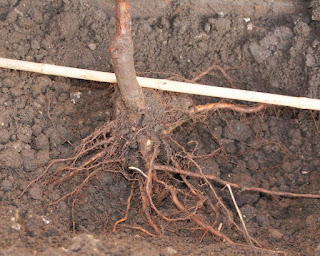 |
| Bareroot Selection in Local Garden Center |
What are bareroot plant? They're all about the timing.
Just like the name suggests, plants with no soil medium around the roots are bare. Bareroot plants are dormant, meaning they are not actively growing so they are not leafed out or blooming. They start out as growing plants in the ground at a wholesale nursery or grower for the retail market and online sales. Plants are then dug from the ground in the fall after they have gone dormant. Once removed from the ground, surrounding soil around the roots are shaken away, plants are refrigerated, and stored until shipping begins to garden centers or directly to you, the customer. Bareroot plants are much lighter in weight which saves on mailing or freight costs.
Local independently owned garden centers often order bareroot plants from wholesale growers to either sell as bareroot to you OR to pot up and sell later. This is common for trees, shrubs, roses, vines and perennials. Once potted by the retailer and placed in warm, sunny, greenhouse conditions, the plant will kick into healthy new growth and often be rooted in the container ready for planting in your garden later in spring.
The plants to look for in garden centers that are bareroot include fruit trees, ornamental trees and shrubs, roses, perennials, strawberry crowns, raspberry "handles," blackberries and asparagus crowns. Not all garden centers sell these types of plants, so call around or visit your favorite local store, you may need other garden supplies anyway.
It's somewhat difficult to tell if the bareroot plant you just purchased is healthy since they mostly look dead. Examine them upon receipt or while in the store (not easy when they are packaged). They shouldn't be moldy or have odor other than an earthy-type smell. Branching and stems shouldn't be broken, or be too light in weight which might indicate they've dried up. The plant should grow and leaf out the first year planted.
 |
| Bareroot Roses Being Potted Up |
Bareroot Care
Ordering a bareroot plant on online or buying locally usually takes some planning. Either you have pre-dug the planting hole when the soil was workable, not frozen or wet (maybe last fall). If you didn't pre-dig but still have dry, workable soil, then you're in luck.
The goal of bareroot planting soon after purchase is to get them planted before growth begins, basically keeping them status quo as dormant until their normal growth cycle begins in spring. In Colorado that means the bareroot planting season can be as early as late February into April.
If bareroot plants can't be planted within a few days, keep them cool and the roots moist, but not wet. An unheated garage, cold basement or crawl space will work. If there's a foot of snow on the area and it will be weeks before it can go in the ground, then pot up the bareroot plant with fresh potting soil into a sterilized container, cover all the roots with soil. Water it after planting and keep it cool, same conditions above. Try not to wrangle too much with the roots by breaking them, treat them gently, they're the life force of your new plant!
Let's Plant
 |
| Grafted Fruit Tree Intenet Photo orangepippintrees.co |
Fill the hole with the removed soil, not adding too much organic matter, otherwise the roots aren't inclined to reach out and establish. It's helpful to enlist assistance for holding the tree or shrub upright while adding soil around the roots. Firm the soil in the hole - but don't hard pack, just enough to prevent air pockets. If the tree is grafted (often the case with fruit trees), be sure the graft is up above ground (above the root flare) one to three inches, same for roses. Once planted, mulch, water it well, no need to fertilize at planting. If staking is needed, place it close to the tree, not in the planting hole, near enough to use nylon traps - only needed for six to twelve months.
Additional Online Resources for Bareroot Planting -
Growing Raspberries in Colorado Gardens
Growing Strawberries in Colorado Gardens
How to Plant Bareroot Perennials
How to Plant Bareroot Trees and Shrubs
How to Plant Rhubarb, Asparagus and Horseradish
Tree Planting No-No's! this is geared more toward planting container or balled and burlapped trees in May, but the same principles apply about planting depth, root flare, and staking
Vegetable Garden Hints
No comments:
Post a Comment
Note: Only a member of this blog may post a comment.